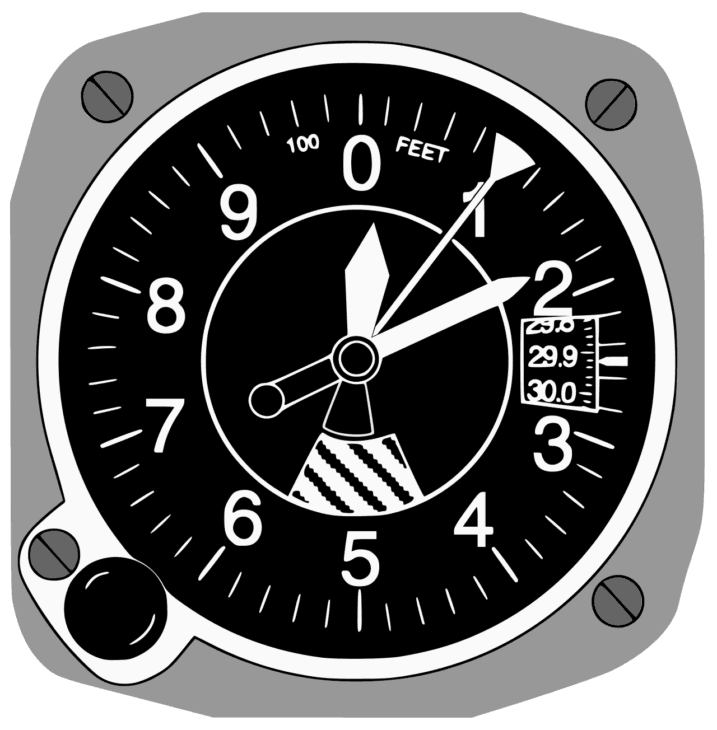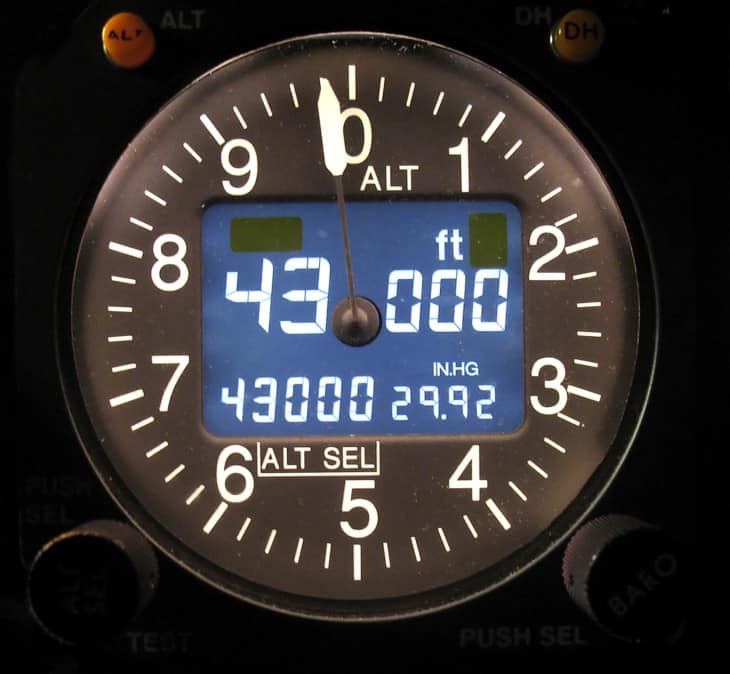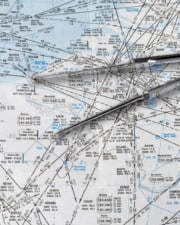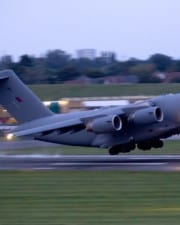Knowing how high you are is an essential part of a pilot’s job, right? But did you realize that pilots are concerned with many different types of altitude, not just how high off the ground they are? Pressure altitude is one such example. So what exactly is pressure altitude?
Table of Contents
Instead of referencing something physical, like sea level or ground level, pressure altitude is the height above standard pressure. The standard pressure at sea level is 29.92 inHg, but it moves around depending on the weather. To make things easier for certain purposes, pilots refer to their height above 29.92 inHg, which is the pressure altitude.
How Altitude is Measured
It’s clear that pilots need to be concerned with altitude, right? Few things could seem more important than knowing how high the airplane is flying. A pilot needs to clear obstacles, fly over mountains, and maintain safe separation from other planes. To do all of these things, they need to know how high they are.
But measuring altitude is a tricky business. A plane doesn’t naturally know how high it is. There are radio altimeters on large aircraft like airliners that measure the plane’s height above the ground. But these only work below 2,500 feet or so, and only the biggest planes have them.
Pretty much every aircraft has a sensitive altimeter onboard. This device doesn’t measure the distance to the ground—it measures air pressure. It’s a pressure-sensitive barometer, but instead of telling the pilot how much the air pressure has changed, it shows its readings in feet (or meters).

Since the altimeter doesn’t know where sea level or ground level is, the pilot needs to calibrate it throughout the flight. It also means that, depending on how that altimeter is set, it could read any number of things.
Types of Altitude in Aviation
- Indicated Altitude — number read off of the instrument’s face
- Calibrated Altitude — indicated altitude corrected for instrument errors
- Pressure Altitude — Height in feet above or below the standard datum plane
- Density Altitude — Pressure altitude corrected for non-standard temperature
- Absolute Altitude — Height above the surrounding terrain
- True Altitude — Height above sea level
That’s a lot of types of altitude. The pilot’s goal is to simplify this list in flight so that they can look at the altimeter and get a meaningful number. In most cases, they want the indicated altitude to be the true altitude.
This is the most significant number since everything on the pilot’s charts is measured from sea level. When they look at airports, mountain ranges, or get an altitude from air traffic control, everything is referencing the true altitude.
The problem with this is that the air pressure changes as the weather changes. Throughout the day, the altimeter setting will change from higher to lower as air masses move around in the atmosphere.
During the flight, a pilot must update their altimeter setting periodically to ensure the altimeter continues to show an accurate reading. Whenever a new air traffic controller is contacted, the controller gives the current altimeter setting for the area.

The Standard Datum Plane (SDP)
Certain standards in aviation were created simply for standardization. When building airplanes, or operating altimeters, it is helpful to know what a “normal” day at sea level looks like. This could then be used as a baseline for aircraft performance.
Of course, in real life, there are few normal days. Air pressure and temperature change with the weather. But someone had to draw a line somewhere.
The line drawn is known as the standard datum plane (SDP). Another way to references this is the International Standard Atmosphere (ISA). The standard conditions at sea level are 29.92 inHg/1013.4 mb and 59 degrees Fahrenheit/15 degrees Celcius.
Why Pressure Altitude is Important to Performance
That’s interesting, but how important are these numbers that make up standard conditions? Pilots consider these numbers far more often than you might imagine.
For one thing, all of an aircraft’s performance data is calculated based on an ISA. The pilot must then correct the numbers to figure out how the plane will act in the actual conditions that it will experience on the day of the flight.
The easiest way to do this is to use the pressure altitude. When discussing things like aircraft performance, the actual location of the ground or sea level doesn’t matter. What does matter is the density of the air.
Pressure altitude is something of an imaginary number used by pilots. They can calculate it based on the weather forecasts, and then they can take that number to their airplane flight manual and look up the performance charts.
Using the pressure altitude, the pilot can quickly figure out:
- How much runway will the plane need to take off?
- How quickly will it climb to clear obstacles?
- How fast will it fly at a specific altitude?
- How much fuel will it burn during a flight?
- How much runway will it need to land?

What is the Pressure Altitude Formula?
How do pilots calculate the pressure altitude? There are two ways.
If an altimeter is handy, the quickest way is to set in standard sea level pressure into the altimeter’s window. By setting 29.92 inHg/1013.4 mb, the altimeter will immediately read pressure altitude.
If no altimeter is handy, a simple math formula will provide the same answer.
Pressure altitude = {(Sea Level Pressure – 29.92) x 1,000} + true altitude (or field elevation if on the ground)
Pressure Altitude Versus Density Altitude
You may notice that the formula for pressure altitude does not take into account air temperature. The standard temperature at sea level is 15 degrees Celcius, and if it’s any warmer than that, the plane will perform as if it’s at a higher altitude.
When you take pressure altitude and correct it for air temperature, the result is known as density altitude.
Calculating density altitude is a little more complicated since the math formula is more complex. Most pilots will break out their flight computers or use a table or chart to figure out the answer.
Most airplane performance charts know this, and they use pressure altitude as the starting point anyway. The first correction the chart makes will be for temperature, so there’s no need to calculate the density altitude.
Flight Levels
Besides being used for performance, the pressure altitude is used for aircraft separation above a particular altitude. The exact point at which the airspace switches from using true altitude above sea level to pressure altitude above the standard datum plane is known as the “transition level.”
In the United States, the transition level is at 18,000 feet. At this point, all pilots set their altimeters to 29.92 inHg. Since all planes are on the same altimeter setting, pilots don’t have to update it again until they descend below 18,000 feet again.
Above 18,000 feet, altitudes are described as flight levels. For example, 24,000 feet would be FL 240, 30,000 feet would be FL300, and so forth.
The transition level is different in every country. In the United States, the transition level is at 18,000 above sea level, but it is as low as 5,000 feet in some countries.
References ▾
Related Posts













